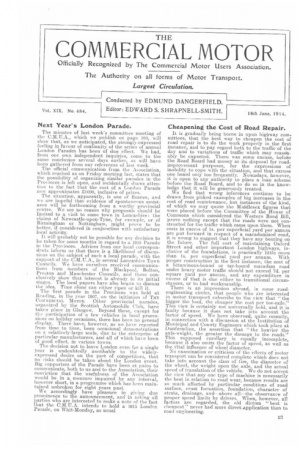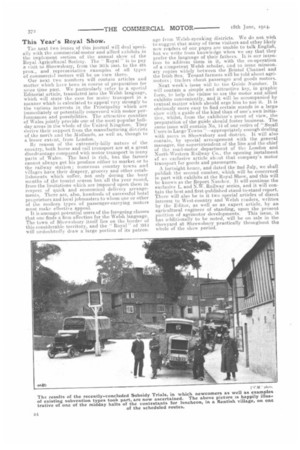Next Year's London Parade.
Page 1

Page 2

If you've noticed an error in this article please click here to report it so we can fix it.
The minutes of last week's committee meeting of the C.M.U.A., which we publish on page 383, will show that, as we anticipated, the strongly-expressed feeling in favour of continuity of the series of annual London Parades has been of due effect. We had, from our own independent inquiries, come. to the same conclusion several days earlier, As will have been gathered from our references of last. week,
The official communication from the Association, which reached us on Friday morning last, states that the possibility of organizing similar parades in the Provinces is left open, and incidentally draws attention to the fact that the cost of a London Parade now approkimates 21000, inclusive of prizes. The situation, apparently, is one of finance, and we are hopeful that evidence of spontaneous assistance will be forthcoming from a worthy provincial centre. We see no reason why proposals should be limited to a, visit to some town in Lancashire: the claims of Newcastle-upon-Tyne, for example, or of Birmingham or Nottingham, might prove to be better, if considered in conjunction with satisfactory local activity.
It will probably not be possible for any decision to be taken for some months in regard to a 1915 Parade in the Provinces. Advices from our local correspondents inform us that there is a. likelihood of discussions on the subject of such a local parade, with the support of the C.M.U.A., in several Lancashire Town Councils. We have ourselves received communications from members of the Blackpool, Bolton, Preston and Manchester Councils, and these conclusively show that interest is already in its initial stages. The local papers have also begun to discuss the idea. Time alone can either ripen or kill it.
The first parade in the Provinces. was held at Reading, in the year 1907, on the initiation of THE COMMERCIAL MOTOR. Other provincial parades, organized by the Scottish Automobile Club, have taken place in Glasgow. Beyond these, except for the participation of a few vehicles in local processions on holiday occasions, there has been no general display. There have however, as we have reported from time. to tune, been OccasiOnal demonstrations on a relatively-large scale, due to the enterprise of particular manufacturers, and all of which have been of good effect, in various towns.
The decision net to leave London even for a single year is undoubtedly ascribable to the widelyexpressed desire on the part of competitors, that no risks should he taken about the London. event. Big supporters of the Parade have been at pains to communicate, both to us and to the Association, their conviction that the usefulness of the Association would be in a. measure impaired by any interval, however short, in a programme which has been maintained unbroken for eight years past.
We accordingly have pleasure in givhig due prominence to the announcement, and in asking all parties who are interested to make a note of the fact that the C.M.U.A. intends to hold a 1915 London: Parade, on Whit-Monday, as usual
Cheapening the Cost of Road Repair.
it is gradually being borne in upon highway committees, that the best way to cheapen the cost of road repair is to do the work properly in the first instance, and to pay regard both to the traffic of the day and to variations of traffic which may reaschiably be expected. There was some excuse, before the Road Board had money at its disposal for roadimprovement purposes, for the expressions of inability to cope with the situation, and that excuse one heard only too frequently. Nowadays, however, it is open to any authority to place a loan scheme before the Road Board, and to do so in the knowledge that it will be generously treated. We find that wrong inferences continue to be drawn from picked examples of big increases in the cost of road maintenance, but instances of the kind, of which we may quote the Middlesex figures that were placed before the Committee of the House of Commons which considered the Western Road Bill, prove nothing except that the roads were not constructed for the traffic which came upon them. When costs in excess of is. per superficial yard per annum are put forward in respect of a macadamized road, it is wrong to suggest that they have any bearing on the future. The full cost of maintaining Oxford Street and other important London highways, inclusive of the foundations, is practically little more than is. per superficial yard per annum. With proper construction in the first instance, the coat of a bituminous-bound or tar-bound macadam road under heavy motor traffic should not exceed 7d. per square yard per annum, and any expenditure in excess of that is due either to transitional circumstances, or to bad workmanship.
There is an impression abroad, in some roadengineering circles, that people who are interested in motor transport subscribe to the vietv that "the bigger the load, the cheaper the cost per ton-mile." This view is certainly not universally held, and it is faulty because it does not take into account the factor of speed. We have observed, quite recently, in connection with a discussion at the Institution of Municipal and County Engineers which took place at Dunfermline, the assertion that "the heavier the axle-weight, the greater the damage to the roads," This supposed corollary is equally incomplete, because it also omits the factor of speed, as well as the Vital influence of wheel diameter.
No examination or criticism of the effects of motor transport can be considered complete which does not take into account the class of tire, the diameter of the wheel, the weight upon the axle, and the actual speed of translation of the vehicle. We do not accept the view that any one type of machine is necessarily the best in relation to road wear, because results are so much affected by particular conditions of road surface, crust formation, foundation, character of strata, drainage, and—above all—the observance of proper speed limits by drivers. When however, all factors are regarded, the old dictum "best is cheapest" never had more direct application than to road engineering. This Year's Royal Show.
The next two issues of this journal will deal specially with the cortunercial-motor and allied eehibits in the implement section of the annual show of the Royal Agricultural Society. The " Royal " is to pay a visit to Shrewsbury, from the 30eh inst. to the 4th prox., and representative examples of all types of commercial motors will be on view there.
Our next two numbers will contain articles and matter which have been in course of preparation for some time past. We particularly refer to a special Editorial article, translated into the Welsh language, which will state the case for motor transport in a manner which is calculated to appeal very strongly to the various interests in the Principality which are immediately or potentially concerned with motor performances and possibilities. The attractive counties of Wales jointly provide one of the most-popular holiday areas in the whole of the United Kingdom. They derive their support from the manufacturing dieeriets of the north and the Midlands, as well as, though to a lesser extent, from London.
By reason of the extremely-hilly nature of the country, both horse and rail transport are at a great disadvantage compared with motor transport in many parts of Wales. The land is rich, but the farmer cannot always get his produce either to market or to the railway station ; numerous country towns and villages have their drapery, grocery and other establishments which suffer, not only during the busy months of the tourist season but all the year round, from the limitations which are imposed upon them in respect of quick and economical delivery arrangements. There are, also, hundreds of successful hotel proprietors and local jobmasters to whom one or other of the modern types of passenger-carrying motors must make effective appeal.
It is amongst potential users of the foregoing classes that one finds a firm affection for the Welsh language. The town of Shrewsbury itself lies on the border of this considerable territory, and the " Royal " of 1914 will undoubtedly draw a large portion of its patron age from Welsh-speaking districts. We do not wish to suggest that manyof these visitors and other likely new reeders of our pages are unable to talk English, but we write from knowledge when we say that they prefer the language of their fathers. It is our intention to address them in it, with the co-operation of a competent Welsh scholar, and to issue missionary copies widely between the Bristol Channel and the Irish Sea. Tenant farmers will be told about agrimotors ; traders about passenger and goods motors.
Next week's issue will the Guide Number. It will contain a simple and attractive key, in graphic form, to help the visitor to see the motor and allied exhibits conveniently, and it will be accompanied by textual matter which should urge him to use it. It is obviously more easy to find certain stands in a large show with a guide of the kind than of one's own initiative, whilst, from the exhibitor's point of view, the preparation of the guide shmeld foster .business. The same issue will contain No. 14 of our series of "Small Users in Large Towns "---appropriately enough dealing with users in Shrewsbury and district.. It will also contain, by special arrangement with the general manager, the superintendent of the line and the chief of the road-motor department of the London and North-Western Railway Co., the opening instalment a an exclusive article abeut that company's motor transport for goods and passengers.
A fortnight hence, and dated the 2nd July, we shall publish the second number, which will be concerned in part with exhibits at the Royal Show, and this will be known as the Report Number. It will continue the exclusive L. and N.W. Railway series, and it will contain the best and first-published stand-to-stand report. There will also be in it two special articles of direct interest to West-country and Welsh readers, written by the Editor, as well as an expert article, by an agricultural engineer of standing, upon the present position of agrimotor developments. This issue, it has additionally to be noted, will be on sale in the showyard at Shrewsbury practically throughout the whole of the show period.
























